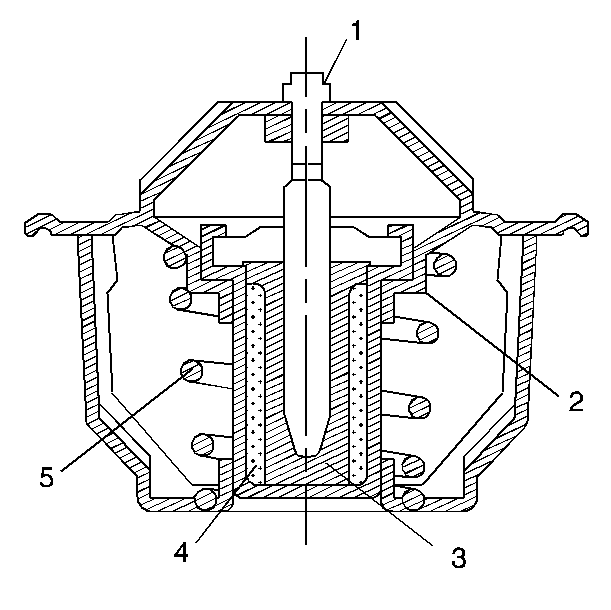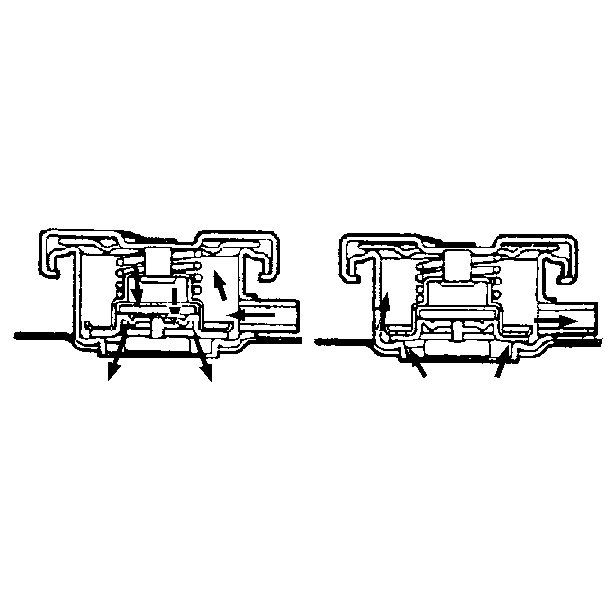Cooling System
The cooling system's function is to maintain an efficient engine operating temperature during all engine speeds and operating conditions. The cooling system is designed to remove approximately one-third of the heat produced by the burning of the air-fuel mixture. When the engine is cold, the coolant does not flow to the radiator until the thermostat opens. This allows the engine to warm quickly.
Cooling Cycle
Coolant flows from the radiator outlet and into the water pump inlet. Some coolant flows from the water pump, to the heater core, then back to the water pump. This provides the passenger compartment with heat and defrost capability as the coolant warms up.
Coolant also flows from the water pump outlet and into the engine block. In the engine block, the coolant circulates through the water jackets surrounding the cylinders where it absorbs heat.
The coolant then flows through the cylinder head gasket openings and into the cylinder heads. In the cylinder heads, the coolant flows through the water jackets surrounding the combustion chambers and valve seats, where it absorbs additional heat.
Coolant is also directed to the throttle body. There it circulates through passages in the casting. During initial start up, the coolant assists in warming the throttle body.
From the cylinder heads, the coolant flows to the thermostat. The flow of coolant will either be stopped at the thermostat until the engine reaches normal operating temperature, or it will flow through the thermostat and into the radiator where it is cooled. At this point, the coolant flow cycle is completed.
Efficient operation of the cooling system requires proper functioning of all cooling system components. The cooling system consists of the following components:
Coolant
The engine coolant is a solution made up of a 50/50 mixture of coolant and suitable drinking water. The coolant solution carries excess heat away from the engine to the radiator, where the heat is dissipated to the atmosphere.
Water Pump
The water pump is a centrifugal vane impeller type pump. The pump consists of a housing with coolant inlet and outlet passages and an impeller. The impeller is mounted on the pump shaft and consists of a series of flat or curved blades or vanes on a flat plate. When the impeller rotates, the coolant between the vanes is thrown outward by centrifugal force.
The impeller shaft is supported by one or more sealed bearings. The sealed bearings never need to be lubricated. Grease cannot leak out, dirt and water cannot get in as long as the seal is not damaged or worn.
The purpose of the water pump is to circulate coolant throughout the cooling system. The water pump is driven by the crankshaft via the drive belt.
Thermostat

The thermostat is a coolant flow control component. Its purpose is to help regulate the operating temperature of the engine. It utilizes a temperature sensitive wax-pellet element (4). The element connects to a valve (2) through a small piston (1). When the element is heated, it expands and exerts pressure against the small piston. This pressure forces the valve to open. As the element is cooled, it contracts. This contraction allows a spring to push the valve closed.
When the coolant temperature is below the rated thermostat opening temperature, the thermostat valve remains closed. This prevents circulation of the coolant to the radiator and allows the engine to warm up. After the coolant temperature reaches the rated thermostat opening temperature, the thermostat valve will open. The coolant is then allowed to circulate through the thermostat to the radiator where the engine heat is dissipated to the atmosphere. The thermostat also provides a restriction in the cooling system, after it has opened. This restriction creates a pressure difference which prevents cavitation at the water pump and forces coolant to circulate through the engine block.
The thermostat begins opening at 82°C (179°F). The thermostat fully opens at 95°C (203°F). The valve lift when the thermostat is fully open measures at least 8 mm (0.31 in).

An air bleed valve (2) is provided in the top of the thermostat. The air bleed valve vents any gas or air that has entered the cooling system.
Radiator
The radiator is a heat exchanger. It consists of a core and two tanks. The aluminum core is a tube and fin downflow design that extends from the inlet tank to the outlet tank. Fins are placed around the outside of the tubes to improve heat transfer to the atmosphere.
The inlet and outlet tanks are a molded, high temperature, nylon reinforced plastic material. A high temperature rubber gasket seals the tank flange edge to the aluminum core. The tanks are clamped to the core with clinch tabs. The tabs are part of the aluminum header at each end of the core.
The radiator also has a drain cock located in the right rear side of the lower tank. The drain cock unit includes the drain cock and drain cock seal.
The radiator removes heat from the coolant passing through it. The fins on the core transfer heat from the coolant passing through the tubes. As air passes between the fins, it absorbs heat and cools the coolant.
Coolant Recovery System
The coolant recovery system consists of a plastic coolant recovery reservoir and overflow tube. The recovery reservoir provides an air space in the cooling system that allows the coolant to expand and contract. The surge tank provides a coolant fill point and a central air bleed location. It is partially filled with coolant and is connected to the radiator fill neck with the overflow tube. Coolant can flow back and forth between the radiator and the reservoir.
In effect, a cooling system with a coolant recovery reservoir is a closed system. When the pressure in the cooling system gets too high, it will open the pressure valve in the pressure cap. This allows the coolant, which has expanded due to being heated, to flow through the overflow tube and into the recovery reservoir. As the engine cools down, the temperature of the coolant drops and a vacuum is created in the cooling system. This vacuum opens the vacuum valve in the pressure cap, allowing some of the coolant in the reservoir to be siphoned back into the radiator. Under normal operating conditions, no coolant is lost. Although the coolant level in the recovery reservoir goes up and down, the radiator and cooling system are kept full.
During vehicle use, the coolant heats and expands. The increased coolant volume flows into the recovery reservoir. As the coolant circulates, any air is allowed to bubble out. Coolant without air bubbles absorbs heat much better than coolant with bubbles.
Pressure Cap

The pressure cap seals the cooling system. It contains a blow off or pressure relief valve and a vacuum or atmospheric valve. The pressure valve is held against its seat by a calibrated spring, which protects the radiator from excessive cooling system pressure. The vacuum valve is held against its seat by a light spring, which permits opening of the valve to relieve vacuum created in the cooling system as it cools off. The vacuum, if not relieved, might cause the radiator and/or coolant hoses to collapse.
The pressure cap allows cooling system pressure to build up as the temperature increases. As the pressure builds, the boiling point of the coolant increases. Engine coolant can be safely run at a temperature much higher than the boiling point of the coolant at atmospheric pressure. The hotter the coolant is, the faster the heat transfers from the radiator to the cooler, passing air.
The pressure in the cooling system can get too high. When the cooling system pressure exceeds the rating of the pressure cap, it raises the pressure valve, venting the excess pressure.
As the engine cools down, the temperature of the coolant drops and a vacuum is created in the cooling system. This vacuum causes the vacuum valve to open, allowing outside air into the surge tank. This equalizes the pressure in the cooling system with atmospheric pressure, preventing the radiator and coolant hoses from collapsing.
Cooling System Indicators
The ECT gauge is controlled by the instrument panel cluster (IPC). The IPC receives a signal from the PCM, which the IPC interprets and converts to a gauge reading.
Air Baffles and Seals
The cooling system uses deflectors, air baffles and air seals to increase cooling system capability. Deflectors are installed under the vehicle to redirect airflow beneath the vehicle and through the radiator to increase engine cooling. Air baffles are also used to direct airflow through the radiator and increase cooling capability. Air seals prevent air from bypassing the radiator and A/C condenser, and prevent recirculation of hot air for better hot weather cooling and A/C condenser performance. Missing, damaged or incorrectly installed air baffles or seals may cause the engine to overheat.
Transmission Oil Cooler
The transmission oil cooler is a heat exchanger. It is located inside the lower end tank of the radiator. The transmission fluid temperature is regulated by the temperature of the engine coolant in the radiator.
The transmission oil pump, pumps the fluid through the transmission oil cooler line to the transmission oil cooler. The fluid then flows through the cooler where the engine coolant absorbs heat from the fluid. The fluid is then pumped through the transmission oil cooler return line, to the transmission.
